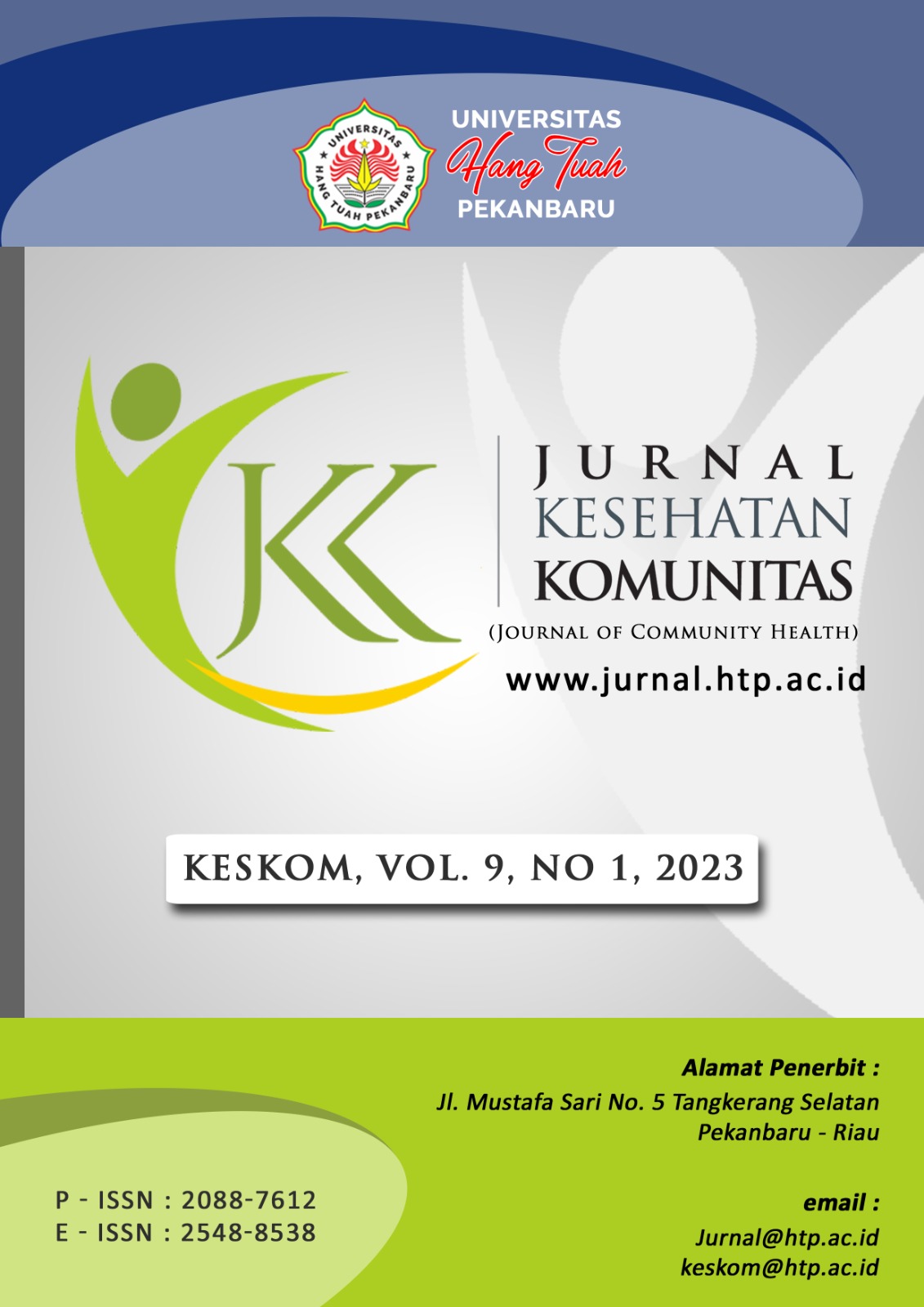Training on the Use of the Book “Balanced Nutrition of Youth: Prevent Stunting” to Improve Adolescent Food Consumption Patterns
DOI:
https://doi.org/10.25311/keskom.Vol9.Iss1.1371Keywords:
gizi seimbang, konsumsi pangan, pengolahan pangan, pola makan, stuntingAbstract
The prevalence of stunting in the Southeast Asia/South-East Asia Regional (SEAR) is 36.4%. One of the efforts to prevent and reduce the prevalence of stunting is to teach teenagers about food consumption patterns based on balanced nutrition. Community service aims to improve adolescent food consumption patterns. The training was conducted from February to d. August 2022 at SMP N 1 Kampar, Kampar District, Kampar Regency. Assessment of adolescent eating patterns was carried out using pre and post-test questionnaires. Questions related to the type, amount, and frequency of eating. The practice of administering food was carried out 3 times at the Food Processing Laboratory of the Integrated Laboratory of Poltekkes, Ministry of Health, Riau on Jl. Melur 103 Pekanbaru City. Assessment of adolescent skills in food administration was carried out by observing using a checklist. The number of participants in the training was 12 teenagers. The result of the activity is an increase in adolescent food consumption patterns by 6.7% from 82.7 to 89.4%. The increase is seen in the frequency of food consumption from 75% to 80%. The type and amount of food consumed by adolescents before the training appeared to be good with a value above 80%. The average practice of processing a balanced menu for teenagers is in a good category with a score above 80%. The conclusion of this activity is that there is an increase in adolescent food consumption patterns after participating in the Training on the Use of the Book "Balanced Nutrition for Adolescents: Prevent Stunting". The type and amount of food consumed by adolescents were good before the training. The frequency of adolescent food consumption became good after the training.
Downloads
References
Rumah Sakit EMC. (2019). Masalah Gizi Paling Umum pada Remaja. Tangerang: EMC.
Kemenkes RI. (2018). Buletin Jendela Data dan Informasi Kesehatan Situasi Balita Pendek (Stunting) di Indonesia. Jakarat : Pusat Data dan Informasi Kementerian Kesehatan Republik Indonesia.
Mokoginta, F. S., Budiarso, F & Manampiring A. E. (2016). Gambaran pola asupan makanan pada remaja di Kabupaten Bolaang Mongondow Utara. Jurnal e-Biomedik (eBm) 4(2):1-10.
Hayati, A. W., Hardinsyah & Rusherina. (2019). Penggunaan Pyridinium Crosslinks Urin sebagai Biomarker Sensitivitas Stunting pada Anak Usia 14 - 15 Tahun. Pekanbaru: Poltekkes Kemenkes Riau.
Widyakarya Nasional Pangan dan Gizi (WNPG). 2004. Lembaga Ilmu:Jakarta.
Hayati, A. W., Hardinsyah & Alza. (2019). Penggunaan Pyridinium Crosslinks Urin sebagai Biomarker Sensitivitas Stunting pada Anak Usia 14 - 15 Tahun. Pekanbaru: Poltekkes Kemenkes Riau.
Olsen, S. O. (2017). ‘Time perspectives and convenience food consumption among teenagers in Vietnam: The dual role of hedonic and healthy eating values Svein’, 110265(167553), p. 110493.
Cowburn, G., Matthews, A., Doherty, A., Hamilton, A., Kelly, P., Williams, J., Foster, C & Nelson, M. (2016). ‘Exploring the opportunities for food and drink purchasing and consumption by teenagers during their journeys between home and school: A feasibility study using a novel method’, Public Health Nutrition, 19(1), pp. 93–103. doi: 10.1017/S1368980015000889.
Hamulka, J., Wadolowska, L., Hoffmann, M., Kowalkowska, J., & Gutkowska, K.. (2018). ‘Effect of an Education Program on Nutrition Knowledge, Attitudes toward Nutrition, Diet Quality, Lifestyle, and Body Composition in Polish Teenagers. The ABC of Healthy Eating Project: Design, Protocol, and Methodology’, MDPI, pp. 1–23. doi: 10.3390/nu10101439.
Singh, J. K., Acharya, D., Rani, D., Gautam, S., Bajgain, K. T., Bajgain, B. B., Park, J., Yoo, S., Poder, T. G., Lewin, A., & Lee, K. (2021). ‘Underweight and associated factors among teenage adolescent girls in resource-poor settings: A cross-sectional study’, Risk Management and Healthcare Policy, 14, pp. 9–19. doi: 10.2147/RMHP.S280499.
Rathi, Neha, Lynn R, & Anthony, W. (2017). "Food consumption patterns of adolescents aged 14–16 years in Kolkata, India." Nutrition journal 16.1: 1-12.
Bo, S., De Carli, L., Venco, E., Fanzola, I., Maiandi, M., De Michieli, F., Marilena., D., Guglielmo., B., Paolo., C.V., Ezio., G., & Ganzit, G. P. (2014). ‘Impact of snacking pattern on overweight and obesity risk in a cohort of 11-to 13-year-old adolescents’, Journal of Pediatric Gastroenterology and Nutrition, 59(4), pp. 465–471. doi: 10.1097/MPG.0000000000000453.
Dietz, T. & Rosa, E. A. (1994). Rethinking the Environmental Impacts of Population, Affluence and Technology. Human Ecology Review, 1, 277-300.
Diethelm, K., Jankovic, N., Moreno, L. A., Huybrechts, I., De Henauw, S., De Vriendt, T., González-Gross, M., Leclercq, C., Gottrand, F., Gilbert, C.C., Dallongeville, J., Cuenca-Garcia, M., Manios, Y., Kafatos, A., Plada, M & Kersting, M. (2012). Food intake of European adolescents in the light of different food-based dietary guidelines: results of the HELENA (Healthy Lifestyle in Europe by Nutrition in Adolescence) Study. Public Health Nutr Mar;15(3):386-98.
doi: 10.1017/S1368980011001935. Epub 2011 Sep 22. PMID: 21936969
Zalewska, M., Zakrzewska, M., Zakrzewski, M., & Maciorkowska, E. (2021). The consumption of vegetables and fruits by teenagers and their nutritional status. Medycyna Ogólna i Nauki o Zdrowiu, 27(1), 60.
doi: 10.26444/monz/133463.
Leroy, J. L., Ruel, M., Sununtnasuk, C., & Ahmed, A. (2018). Understanding the determinants of adolescent nutrition in Bangladesh. Annals of the new York Academy of Sciences, 1416(1), 18-30 doi: 10.1111/nyas.13530.
Subashini, K., Sunmathi, D., & Nalinakumari, S. (2015). Prevalence of overweight and obesity among private and government school children. Int J Adv Eng Sci. ;4:48–66.
Alkhulaifi, F., & Darkoh, C. (2022). ‘Meal Timing , Meal Frequency and Metabolic Syndrome’, (March). doi: 10.20944/preprints202203.0294.v1.
Robson, S. M., McCullough, M. B., Rex, S., Munafò, M. R., & Taylor, G. (2020). Family meal frequency, diet, and family functioning: a systematic review with meta-analyses. Journal of nutrition education and behavior, 52(5), 553564.https://doi.org/10.1016/j.jneb.2019.12.012
Bargiota, A., Pelekanou,M., Tsitouras, A & Koukoulis,G. N. (2013). Eating habits and factors affecting food choice of adolescents living in rural areas. Hormones (Athens). doi: 10.14310/horm.2002.1408. PMID: 23933693.
Hembree, M. E. (2018). Adolescent Fruit and Vegetable Consumption in Relation to Frequency and Timing of Eating Occasions : Findings from the DASH-4-Teens Trial. University of Cincinnati.
Bailey, C. J., Drummond, M.J., & Ward, P. R. (2019). ‘Food literacy programmes in secondary schools: A systematic literature review and narrative synthesis of quantitative and qualitative evidence’, Public Health Nutrition, (July). doi: 10.1017/S1368980019001666.
Lavelle, F., Spence, M., Hollywood, L., McGowan, L., Surgenor, D., McCloat, A., Mooney, E., Caraher, M., Raats, M., & Dean, M. (2016). Learning cooking skills at different ages: a cross-sectional study. International Journal of Behavioral Nutrition and Physical Activity, 13(1), 1-11. doi: 10.1186/s12966-016-0446-y.
Gustavsson, J., Cederberg, C., Sonesson, U., van Otterdijk, R., & Meybeck, A. (2011). Global Food Losses and Food Waste: Extent, causes and Prevention. FAO Rome, Italy.
Lipinski, B., Hanson, C., Waite, R., Searchinger, T., & Lomax, J. (2013). Reducing food loss and waste. Working paper, Instalment 2 of creating a sustainable food future. World Resources Institute, Washington, DC. http://www.worldresourcesreport.org.
Huang, I. Y., Manning, L., James, K. L., Grigoriadis, V., Millington, A., Wood, V., & Ward, S. (2021). ‘Food waste management: A review of retailers’ business practices and their implications for sustainable value’, Journal of Cleaner Production, 285. doi: 10.1016/j.jclepro.2020.125484.
Kummu, M., de Moel, H., Porkka, M., Siebert, S., Varis, O., & Ward, P. J. (2012). Lost food, wasted resources: global food supply chain losses and their impacts on freshwater, cropland, and fertiliser use. Sci. Total Environ :438(0):477–489.
Da Silva Farias, A., Akutsu, R. D. C. C. D. A., Botelho, R. B. A., & Zandonadi, R. P. (2019). ‘Good practices in home kitchens: Construction and validation of an instrument for household food-borne disease assessment and prevention’, International Journal of Environmental Research and Public Health, 16(6). doi: 10.3390/ijerph16061005.
Moretro, T., Martens, L., Teixeira, P., Ferreira, V. B., Maia, R., Maugesten, T., & Langsrud, S. (2020). Is visual motivation for cleaning surfaces in the kitchen consistent with a hygienically clean environment?. Food Control, 111, 107077.
doi: 10.1016/j.foodcont.2019.107077.
Downloads
Submitted
Accepted
Published
How to Cite
Issue
Section
License
Copyright (c) 2023 Jurnal Kesehatan Komunitas

This work is licensed under a Creative Commons Attribution-NonCommercial-ShareAlike 4.0 International License.
Copyright @2017. This is an open-access article distributed under the terms of the Creative Commons Attribution-NonCommercial-ShareAlike 4.0 International License (http://creativecommons.org/licenses/by-nc-sa/4.0/) which permits unrestricted non-commercial used, distribution and reproduction in any medium












































